| Release List | Reviews | Price Search | Shop | Newsletter | Forum | DVD Giveaways | Blu-Ray/ HD DVD | Advertise |
| Reviews & Columns |
|
Reviews DVD TV on DVD Blu-ray International DVDs Theatrical Reviews by Studio Video Games Features Collector Series DVDs Easter Egg Database Interviews DVD Talk TV DVD Talk Radio Feature Articles Columns Anime Talk DVD Savant HD Talk Horror DVDs Silent DVD
|
DVD Talk Forum |
|
|
| Resources |
|
DVD Price Search Customer Service #'s RCE Info Links |
|
Columns
|
 |
The Marlon Brando Collection
|
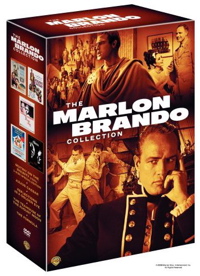
|
Warner Bros. Julius Caesar, Mutiny on the Bounty, Reflections in a Golden Eye, The Teahouse of the August Moon, The Formula Starring Marlon Brando Street Date November 7, 2006 59.98 the boxed set Two titles available separately Reviewed by Glenn Erickson |
Universal's Marlon Brando The Franchise Collection from last year pulled together four of the actor's lesser accomplishments of the 1960s. This year's The Marlon Brando Collection cleans out the Brando closet at Warners with five titles that constitute a better overall selection. Two very popular efforts precede three from Brando's later career, when critical assessments often included potshots at his quirky personal life, political commitments and sometimes baffling choices of roles.
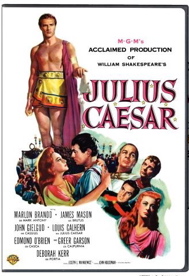
Julius Caesar
1953 / 120 min. / available separately at 19.98
Starring Marlon Brando, James Mason, John Gielgud, Louis Calhern, Edmond O'Brien, Greer Garson, Deborah Kerr
Cinematography Joseph Ruttenberg
Art Direction Edward Carfagno, Cedric Gibbons
Film Editor John Dunning
Original Music Miklos Rozsa
Written by Joseph L. Mankiewicz (uncredited) from the play by William Shakespeare
Produced by John Houseman
Directed by Joseph L. Mankiewicz
When a Warners screenwriter had the misfortune to be credited on the 1936 A Midsummer's Night Dream as helping out William Shakespeare with 'additional dialogue,' he instantly became the butt of jokes. Writer-director Joseph L. Mankiewicz wisely did not take credit for his work on the bard's Julius Caesar, which he adapted to massive acclaim in this 1953 hit. Perhaps the most successful conversion of Shakespeare to the screen, this MGM production entertains while simultaneously pleasing English majors with its interpretation and editing choices. Atop a glittering cast is Marlon Brando, proving himself more than adequate to a role requiring precise elocution: No mumbling Mark Antonys 'round here.
Julius Caesar is almost unique among Shakespeare adaptations in that viewers unacquainted with the play can fully understand and appreciate it. Actors John Gielgud, James Mason and Louis Calhern speak clearly and communicate the intent of their lines with perfect gestures, aided by Mankiewicz's expressive camera. The familiar movie actors in the large supporting cast concentrates on effectively putting their parts across, as opposed to honoring the form of the Elizabethan dialogue.
Part of the excitement derives from the stark universality of the original play. Everyone can identify with the tale's brutal struggle for power. Cassius is chagrined that a man he once saved from drowning is now his superior. Brutus fears that Caesar is robbing him of a glorious personal destiny. The various senators and conspirators maneuver to be on 'the right side' and harbor valid grudges of their own, but the unifying factor is that they fear and loathe a leader who becomes too popular.
The conspiracy festers in its own world of resentment, as Caesar has outwardly done nothing and three times turns down a public appeal to crown himself full dictator. The senators don't trust him regardless of his actions. The story is about the corruption of power -- or better, the corruption of men who covet power.
It's of course terrific to see screen favorites known for action and thriller roles interacting so well with the likes of Gielgud and Mason. Calhern is terrific as Caesar and Edmond O'Brien adds tension whenever he's on screen. Greer Garson and especially Deborah Kerr (as Portia) have one-scene roles and make less of an impact. But the parade of lesser screen notables brightening up the proceedings is genuinely impressive. Citizens in the early scenes include George Macready (Gilda), Michael Pate, John Doucette (The Fountainhead) and Ned Glass (West Side Story). Among the scheming senators and powerful citizens are John Hoyt, Alan Napier, Tom Powers, Ian Wolfe and Thomas Browne Henry. Mark Antony's messenger-servant is the ubiquitous William Phipps, and Douglass Watson is Octavius Caesar, Julius' rightful successor. Later soldiers and slayers are Douglass Dumbrille, Rhys Williams, Michael Ansara, Dayton Lummis and finally Edmund Purdom, soon to take over for Brando in The Egyptian.
Julius Caesar's last act takes place on interior sets, but the big battle makes excellent use of Bronson Caverns, often showing the entire quarry. Brando and his ambushers wait halfway up the sides of the hill and charge down the steep slopes. The rather small area is greatly enhanced with clever matte paintings, and in one angle we wonder why we can't see the Hollywood Sign.
Julius Caesar's handsome flat B&W image is accompanied by a stereo soundtrack enlarged to 5.1 . We're told that the original track from 1953 was prepared in stereo but released mono. Extras include the new featurette The Rise of Two Legends, an introduction by Turner Classic Movies' Robert Osborne and a string of Marlon Brando trailers.
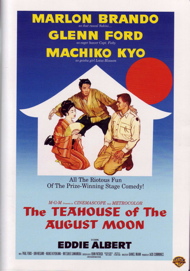
The Teahouse of the August Moon
1956 /123 min. / Not Available Separately
Starring Marlon Brando, Glenn Ford, Machiko Kyô, Eddie Albert, Paul Ford
Cinematography John Alton
Art Direction William A. Horning, Eddie Imazu
Film Editor Harold F. Kress
Written by John Patrick from his play, from the book by Vern J. Sneider
Produced by Jack Cummings
Directed by Daniel Mann
The immensely popular The Teahouse of the August Moon satirizes the American occupation of Japan (1945-1952) not by showing conditions on the Japanese mainland but by concocting a sweet and rather condescending comedy of errors in a tiny Okinawan village. Some aspects have dated but audiences still respond to a clueless officer's efforts to bring enlightenment and democratic values to a deceptively 'cooperative' hamlet: The peasants shrewdly get their way in all disputes. Marlon Brando's impersonation of a Japanese servant was reportedly so convincing, some 1956 theatergoers complained that they sat through the whole movie and didn't realize he was in it.
The Teahouse of the August Moon takes a bit of getting used to. Service comedies were certainly starting to become common (the next year's Operation Mad Ball) but John Patrick's 1953 play, from a 1951 book, is more than a romp about devious non-coms, idiotic officers and sexy Navy nurses. The Occupation was still a serious issue and was considered highly successful in that there were no revolt attempts against MacArthur's rule. The story is set on Okinawa less than a year after a bloody U.S. invasion marred by the mass suicide of entire villages convinced that the Americans would butcher them.
Therefore it's disconcerting at first to see the presentation of the Okinawans as 'cute' and inoffensive 'little people.' Only slowly do we realize that they are the ones in control of the situation, and by the end the film is awarding them full respect while lampooning the American military as hopeless dummies. The broad Army comedy isn't very clever and it can be argued that the Okinawans are still presented as funny aliens, enamored of watching sunsets and well versed in flummoxing their occupiers. But the film has touches of genuine charm, as when the smiling Sakini offers sage advice: "Pain makes man think. Thought makes man wise. Wisdom makes life endurable."
Almost all of the humor is the result of poor communication, or taking advantage of poor communication. Marlon Brando's Sakini is a natural prankster who uses his charm and guile to completely derail Captain Fisby's mission. He completely manipulates the situation by selectively interpreting, or misinterpreting, Fisby's words. Fisby finds himself saddled with a cloying Geisha and bamboozled by the chaos of his Democratic Women's Club. The only way out is to give up and help the villagers do what they want ... at which point they become amazingly efficient and resourceful. The American values Fisby inculcates skip educational needs in favor of big profits from the booze business. An excellent sequel idea would happen the next year, when other villages compete for the liquor trade and start gang wars. It could be a microcosm of America in the 20th century.
Brando is charming as hell provided his makeup and manner don't offend; unlike Mickey Rooney's atrocious Japanese act in the later Breakfast at Tiffany's, people who knew the Okinawans reported that Brando's coached manner and behaviors were fairly authentic. Today any such cross-race casting is considered PC poison, which only seems a good thing when so many ill-advised examples stain the filmic record: Ricardo Montalban in Sayonara, anybody?
Daniel Mann's direction is mostly flat, with many scenes played out in static CinemaScope wide shots. Legendary cameraman John Alton's work doesn't seem all that distinguished until the 3rd Act teahouse sequences with their moving screens and arresting colors. Machiko Kyô's clownish Lotus Blossom transforms into a beautiful dancer, with some clever instantaneous costume changes .... how did they do that?
Brando's character disappears for big sections of the picture, as when psychiatrist Eddie Albert visits and indulges his passion for gardening. Paul Ford got the job as the C.O. after actor Louis Calhern died suddenly on location. Harry Morgan (TV's M*A*S*H) is a dim-bulb sergeant. Nijiko Kiyokawa is animated as the Women's Club leader Miss Higa Jiga, and little Mitsuko Sawamura was exploited in a lot of MGM promos, and showcased in the desperate musical Meet Me in Las Vegas.
The Teahouse of the August Moon's one unique extra is a B&W featurette called Operation Teahouse. It mostly records the stars in a lot of publicity opportunities on the Japanese sets.
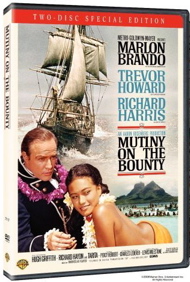
Mutiny on the Bounty
1962 / Color / 2:40? anamorphic 16:9 / 185 min., with Overture and Entr'acte / Street Date November 7, 2006 / Available separately at 26.98
Starring Marlon Brando, Trevor Howard, Richard Harris, Hugh Griffith, Richard Haydn, Tarita, Percy Herbert, Duncan Lamont, Gordon Jackson, Chips Rafferty, Noel Purcell
Cinematography Robert L. Surtees
Art Direction George W. Davis, J. McMillan Johnson
Film Editor John McSweeney Jr.
Original Music Bronislau Kaper
Written by Charles Lederer from the novel by Charles Nordhoff, James Norman Hall
Produced by Aaron Rosenberg
Directed by Lewis Milestone
The two-disc special edition of Mutiny on the Bounty is reviewed separately at this URL.
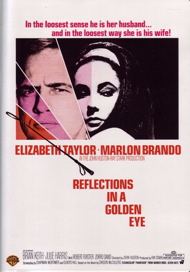
Reflections in a Golden Eye
1967 / 108 min. / Not available separately
Starring Elizabeth Taylor, Marlon Brando, Brian Keith, Julie Harris, Zorro David, Gordon Mitchell
Cinematography Aldo Tonti
Production design Stephen Grimes
Art Direction Bruno Avesani
Film Editor Russell Lloyd
Original Music Toshirô Mayuzumi
Written by Gladys Hill, Chapman Mortimer from the novel by Carson McCullers
Produced by John Huston, Ray Stark
Directed by John Huston
Reflections in a Golden Eye is likely to force a small but intense minority to buy the entire Brando set, when they only wanted the one title. John Huston's overheated version of Carson McCullers' book is one of the movies that brought on the 1968 MPAA ratings system; it was an 'adults only' studio production with discreet nudity but no bad language. Practically every character has a weird sexual perversity to hide, or flaunt. Erotic obsessions both expressed and repressed drive the narrative to a bloody and unhappy end.
Reflections in a Golden Eye is one of the more controversial productions of the late 1960s. Gossip about Liz Taylor and Brando is joined by the sad story of Montgomery Clift, who prepped for the role but died in advance of shooting. Critics can't seem to decide if the film represents a creative apex or a career nadir for director John Huston.
Viewers attracted by challenging sexual content usually revel in Golden Eye's examination of just about every perversion on the books. There's heterosexual adultery and frustrated homosexual passion; resentments are expressed through sexual denial, exhibitionism, whippings and even a reference to a grisly female self-mutilation. Symbols runs riot with horse riding representing sexual humiliation and unspoken passions. And to top it all off, Huston adds another film to his color stylization experiments by printing all colors except red in a sickly yellow-sepia, making the whole show a 'reflection in a golden eye. 1
The film is a resolutely joyless exercise that could be described as The Kinsey Report crossed with Edgar Allan Poe. Spoiled Army brat Leonora delights in playing emasculation games, flaunting her superior horse riding skills as proof of Weldon's sexual inadequacy, and forcing him to watch her (or her body double) ascend a flight of stairs in the nude. The guilty Morris doesn't know what to make of the diminutive Anacleto's prancing about with his watercolor of a peacock with a golden eye. Does the golden eye account for the movie's warped color scheme? Are all the characters stylized to reflect only their aberrant passions? Somebody consult the guidebook.
From its credits, Reflections in a Golden Eye appears to be mostly shot in Rome, which makes sense when one imagines how the U.S. Army might respond if they were given this script, and asked for military cooperation. The sex-crazed officers on this post aren't exactly material for recruiting posters. Brian Keith's Morris has ignored and neglected his wife Alison to the extent that she's retreated from reality. It's implied that another officer (Irvin Dugan) is being passed over for promotion not for 'leadership failings' but because he openly displays his love for classical music ad art; in other words, he's gay. It's also surprising that nobody notices Brando's Weldon Penderton, as he spends half the movie staring wistfully and painfully at the object of his affections, the thin young Private Williams. Weldon's obsession is such that he literally can't stop ogling Williams, even during a boxing match or at the scene of a car wreck. The private also turns out to be a psycho. A mysterious sun-worshipper by day, he goes on nightly creepy-crawly excursions to Leonora's bedroom, to do who-knows-what with her lacy underthings. Join the Army!
Brando is certainly committed to the role, and Liz Taylor acquits herself well enough, working up a frenzy to lash out at Brando during an officer's party -- you'd think that would have the Base Commander looking in the service manual under "S&M" for guidance. Brian Keith's Langdon is the most convincing personage, perhaps because his little adultery problem relatively tame. Julie Harris is effective for not having much screen time. The mincing Anacleto is entirely dubbed by Paul Frees, in what must be his best re-voicing performance ... the little guy eventually becomes the film's most righteous character. Robert Forster makes his screen debut in a crazy role, and plays it almost without talking. Ex-muscleman Gordon Mitchell is the sergeant in charge of the stables. Young Harvey Keitel and Sergio Leone favorite Al Mulock also have tiny bits as soldiers ... I didn't spot Keitel.
The DVD of Reflections in a Golden Eye looks plenty odd with its sickly 'golden' glaze color effect. After a while other colors start to show through the haze, but the main result in the viewer is to make ordinary reality look all that much better after the movie's over. An occasional shirt or accent flower sits in the middle of a yellowish scene, screaming 'symbol' at us ... the art-movie attitudes of Reflections in a Golden Eye tend to drag the whole affair into Kraft-Ebbing Land. Who knows how weird this would have been if the tortured-looking Montgomery Clift had played the uneasy Major Weldon -- although it comes from a famous author, Huston's movie sometimes seems like a joke invented on the set of his Freud.
The one extra is a lengthy series of unedited B&W dailies from the set clearly filmed for a never-made behind-the scenes featurette. It's a fascinating actual glimpse at the process of filming. John Huston at least, seems to be having a great time.
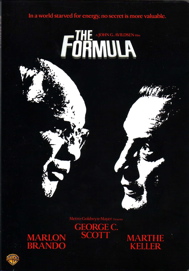
The Formula
1980 / 117 min. / Die formel / Not Available Separately
Starring George C. Scott, Marlon Brando, Marthe Keller, John Gielgud, G.D. Spradlin, Beatrice Straight, Richard Lynch, John Van Dreelen
Cinematography James Crabe
Production design Herman A. Blumenthal
Film Editor John Carter
Original Music Bill Conti
Written by Steve Shagan from his novel
Produced by Steve Shagan
Directed by John G. Avildsen
From the makers of two of the worst award-winning films of the 1970s comes The Formula, an expensive globe-hopping mystery thriller that devolves into an unforgivably simple-minded jab at the oil cartels, presenting scheming oil barons as modern Blue Meanies threatening our gas-guzzling happiness. If you thought the conclusion of Three Days of the Condor was brilliant filmmaking, this picture's paint-by-numbers moralizing might appear to be relevant. But it's really a lot of dead-end thriller clichés in search of an easy target. Marlon Brando gives a solid supporting performance as the Bluest Oil Meanie of them all, the kind of lukewarm Mabuse that reluctantly admits that people (sigh) sometimes have to be sacrificed to maintain the balance of the celestial spheres of big business.
Steve Shagan must have been caught in a gas rationing line in 1974 or 1979; this topical thriller can't conceive of anything worse than the public being bamboozled by price-fixing and profiteering at the pump. What's unfortunate is that the writer-producer drags out tired conspiracy plotting and paranoid spy schtick to tell a non-story about a murder investigation that unravels into an exposé of --- a Nazi curse!
Remember the perennial scam about pills that turn water into gasoline? This story pretends that from 1938 onward, Hitler was making gasoline from coal in huge refineries/ Yet at the war's end only a handful of Reich muckety-mucks knew of its existence. In an extended prologue we see the secret formulas captured by the U.S. Army, only to later find that an American Officer and a German general have held the formula in secret, so as to give the Evil Big Oil Companies (a German-American cartel that the film claims maintained ties throughout the war) a free hand to manipulate Oil prices.
The Formula most resembles a desultory non-remake of Mr. Arkadin, the Orson Welles movie about a detective hired to locate people from a famous man's past, so the famous man can have them all murdered. Barney Caine's interview subjects are predictably shot dead, both here and in Germany and Switzerland. We even see Caine's superior (Alan North) report to his Oil Cartel contact as soon as Caine is on his way to Germany. Lisa, a sexy German helper (Marthe Keller) translates for Caine and beds him as they go from city to city. We can guess immediately that she's a double agent. Caine's 'investigation' is a total botch, as assassins rub out everyone they contact. When the Little Old German Gasoline Maker (John Gielgud) gives Caine the secret formula, Lisa is right there to intercept it. One copy reaches Caine's trusted parttner Louis Yosuda (Calvin Young), and unseen kidnappers scoop the detective up like kitty litter. It's a conspiracy, I tells ya.
Since the cartel should already know who these men and their contacts are, and the object is to eradicate them and bury the formula, Detective Caine's function in the grand scheme is never made clear -- perhaps the book makes better sense of this. The various victims aren't around long enough to make much of an impression; top talents like Beatrice Straight aren't given much to do beyond look worried and then suffer surprise high-powered bullet impacts. Most are killed off-camera, but Ferdy Mayne's head blows up right in our faces. The casting people proffer a list of familiar names: Richard Lynch (who also figures in the 1945 segment), John Van Dreelen, Wolfgang Preiss, G.D. Spradlin. Marshall Thompson drops in for a tiny bit, perhaps to help him qualify for an extra SAG benefit.
Marlon Brando is more than effective in his three (count 'em, 3) scenes, looking paunchy, with a fake comb-over hairdo and fake teeth to give his mouth a Neanderthal bulge. He shovels the BS onto George C. Scott in the first meeting and argues with his pool man over chlorine and a frog in a Chinatown rip-off scene. Brando finishes the picture with a victory speech worthy of Sherlock Holmes' Professor Moriarty, basically confessing to mass murder in the name of global prosperity. Realizing that he's utterly powerless before the mighty Brando, George C. Scott wanders out to give us a final look at a crowded freeway for a 'heavy, dude, heavy' finish.
Frankly, the film is so heavy-handed it makes this viewer almost want to petition for higher gas prices and more perks for oil executives. Well, almost. I can't help but conclude that the thought behind this show goes no deeper than "Oil Companies ... Baaaad."
The photography is fairly good and both Scott and Brando are in fine form. Marthe Keller reprises the same basic role she played in Frankenheimer's Black Sunday, only without a character to go with it. One moment does stick out, when the Berlin Chief of Police tells Caine that we Americans are lucky because we haven't yet been targeted by international terrorism. The prophetic line falls limp, because The Formula doesn't acknowledge the existence of 'bad guys' beyond corporate Oil Men in glass towers. When asked about the Arabs, Brando's character yelps, (para.) "You don't get it, do you? We are the Arabs."
The Formula looks fine on this enhanced DVD, with excellent color and detail. The sole extra is a commentary by director John G. Avildsen and writer-producer Steve Shagan. We hear a lot of self-congratulation and name-dropping. Then, when pointing out the agreeable actor (Robin Clarke) who plays the first murder victim as a young officer in WW2, Avildsen and Shagan can't remember who he is and offhandedly dismiss him as a nobody who went nowhere. After that Savant only listened to their track intermittently. Mr. Clarke had a perfectly respectable career both before and after The Formula.
On a scale of Excellent, Good, Fair, and Poor,
|
Julius Caesar rates:
Movie: Excellent Video: Excellent Sound: Excellent Supplements: Introduction by TCM host Robert Osborne, New featurette The Rise of Two Legends, Trailers |
Mutiny on the Bounty rates:
Movie: Excellent Video: Excellent Sound: Excellent Supplements: Prologue and epilogue sequences not seen theatrically, Four vintage featurettes, Marlon Brando movies trailer gallery, New featurette After the Cameras Stopped Rolling: The Journey of the Bounty |
|
Reflections in a Golden Eye rates:
Movie: Good - Video: Excellent but Mellow Yellow, quite rightly Sound: Excellent Supplements: Vintage behind-the-scenes footage, trailers |
The Teahouse of the August Moon rates:
Movie: Very Good Video: Excellent Sound: Excellent Supplements: Vintage featurette Operation Teahouse, trailers |
|
The Formula rates:
Movie: Fair Video: Excellent Sound: Excellent Supplements: Commentary by director John G. Avildsen and screenwriter Steve Shagan, trailer |
Packaging: One keep case and four slim cases in Card Box Reviewed: November 14, 2006 |
Footnote:
1. A disclaimer says that this so-called 'golden' look played only a few days in theaters before Warners replaced the prints with copies with normal hues. This DVD claims to reproduce Huston's original color scheme.
Return
Review Staff | About DVD Talk | Newsletter Subscribe | Join DVD Talk Forum
Copyright © MH Sub I, LLC dba Internet Brands. | Privacy Policy | Terms of Use
|
| Release List | Reviews | Price Search | Shop | SUBSCRIBE | Forum | DVD Giveaways | Blu-Ray/ HD DVD | Advertise |





